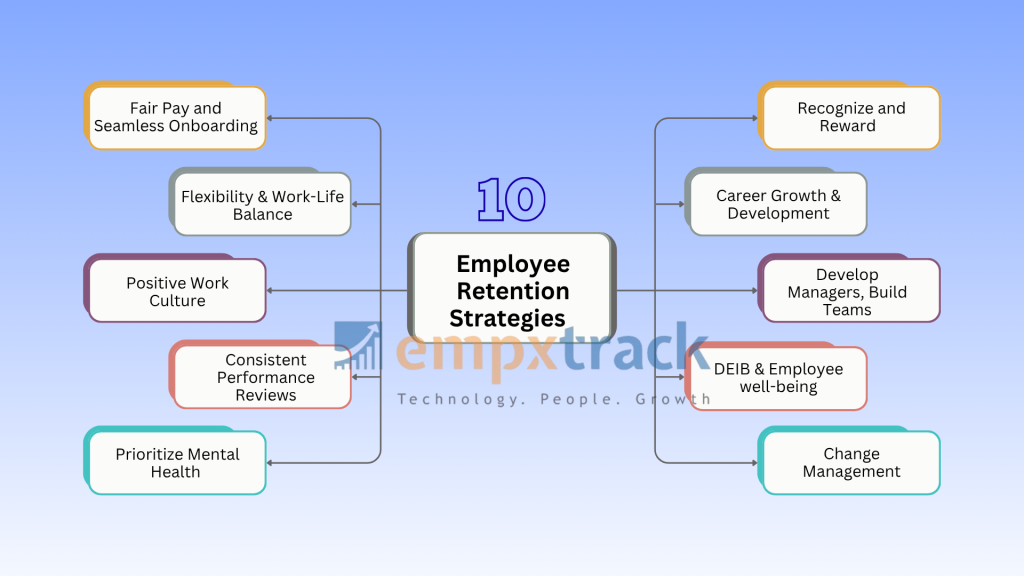Employee retention strategies matter more than ever, not just due to the cost of turnover but because retaining top talent requires real effort and a well-executed strategy.
According to the Bureau of Labor Statistics, nearly half of employees admit they’ve had second thoughts about their job, and it happens within the first week. This is already a sign that the organization needs to work on its retention strategies.
The best employee retention strategies are the ones that connect directly to the employee experience. In this blog, you will read about the importance of employee retention and various effective staff retention strategies to strengthen loyalty.
Table of Contents
What is Employee Retention?
Employee retention is an organization’s ability to retain its current employees. It is associated with employee experience, as a positive experience is related to a higher intent to stay.

Employee retention strategies are actions that organizations take to keep their employees satisfied and productive at work. Moreover, a thoughtful employee retention program or a detailed employee retention plan can make a huge difference in sustaining top talent.
Importance of Employee Retention
Employee retention is vital for maintaining organizational stability. High retention ensures that valuable skills, knowledge, and experience remain within the company, thus reducing disruptions in workflow. Moreover, employee turnover can negatively impact a business’s performance and lead to a high attrition rate in the organization. Today, it’s very common for employees to switch companies, as the stigma attached to job hopping has largely disappeared. Rather, HR professionals are under pressure to effectively manage the workforce by addressing the cause of turnover and strengthening retention.
By retaining employees, companies can lower their recruitment and hiring costs. As constant turnover requires time, money, and expertise to backfill a position.
Productivity also suffers when a high-potential employee leaves the company. Not only this, but the organization’s morale and culture are impacted, too. This can lead to a loss of team cohesion and a decline in the overall organizational performance.
Therefore, high-performing organizations must focus on employee engagement and retention. Moreover, they must build a reliable talent retention strategy that keeps critical roles filled and reduces disruption.
Why are Employees Leaving?
Employees leave their companies for various personal and professional reasons, and HR professionals can identify these through detailed exit interviews and surveys. The most common reasons include fair and competitive salaries.
Employees who believe they’re paid unfairly are 45% more likely to look for a new job, regardless of actual compensation. They will look for better job opportunities at other companies.
However, money is not the only factor influencing retention. Employees also value comprehensive benefits such as health insurance and retirement plans that contribute to their overall well-being. Besides this, they also place equal emphasis on work-life balance and career growth and development opportunities.
Other leading reasons for employee turnover include a toxic or negative workplace environment, hectic work schedule, dirty office politics, poor leadership, or dissatisfaction with one’s supervisor or manager.
Furthermore, it has been observed that employees are more likely to stay with an employer who is empathetic to their needs. A survey by La Trobe University (Australia) of over 4,000 workers with dependent children found that up to half of working parents report experiencing discrimination at work because of their parental status. This prompted them to quit their organization.
However, implementing thoughtful HR retention strategies can help address these issues and reduce employee turnover.
Employee Retention Strategies

1. Offer Fair Pay and Seamless Onboarding
Employee retention is driven by offering fair and competitive rates. If employees believe they are underpaid, they will look for another job.
Similarly, onboarding is a vital tool for retaining employees. Organizations can increase their retention rates if they equip their new hires with the resources and support needed to succeed in their job roles. This includes addressing their queries, fostering cultural understanding, and facilitating meaningful connections with core stakeholders.
It is reported that 69% of employees are more likely to stay for 3+ years if they experience good onboarding. (Source: Brandon Hall Group)
2. Consider Flexibility and Work-Life Balance
Working long hours or answering emails at night can lead to higher attrition rates and take a toll on overall job satisfaction. Hence, organizations should actively encourage a healthy work-life balance and help employees stay recharged and active. Moreover, paid time off should be encouraged.
A 2025 survey found that 65% of employees are more likely to stay with a company that offers flexible work arrangements (remote or hybrid).
3. Create a Positive Work Culture
A positive work culture extends far beyond onboarding; it has to resonate throughout the entire employee lifecycle. Company culture does not live in PowerPoint; it lives in daily behavior. It is felt in how values are respected in day-to-day work and how employees are treated. Focusing on trust, respect, and collaboration supports both stronger employee engagement and retention strategies that last.
According to Redgrave’s State of U.S. Workplace Culture 2025 report, organizations with strong workplace cultures see up to 80% higher employee retention.
4. Consistent Performance Reviews
If your organization is conducting a year-end review, it should be consistent with regular check-ins and continuous feedback. Ongoing feedback and transparent communication are some of the best retention strategies any HR team can implement. Effective performance management strategies also include SMART goal setting, learning and development, which evolves with the work.
5. Prioritize Mental Health or Resilience
This is one of the primary reasons for employee attrition, and it should be addressed before it begins to affect the workforce. Organizations can prevent this by closely monitoring workloads, promoting healthy boundaries, and encouraging employees to take time off. Proactive support will allow employees to breathe and recover before burnout takes hold.
Survey by HRStacks: 62% of employees feel burned out at work in 2025; 68% of Gen Z and 73% of millennials say they feel burned out and are actively considering job changes due to stress.
6. Recognize and Reward Frequently
Recognition is easily one of the most effective ways to retain employees. Simple retention ideas like shout-outs or peer appreciation can go a long way. This, in turn, reinforces behavior that promotes actions that nurture culture, boost performance, and build stronger connections.

According to Gallup & Workhuman tracking, employees who receive high-quality recognition are 45% less likely to leave after two years.
7. Invest in Career Growth and Professional Development
Employers should invest in learning opportunities that align with employees’ career goals. This subsequently fosters engagement and loyalty amongst the workforce. The acknowledgment of acquiring new skills is one of the most sustainable staff retention ideas that will instill positivity in employees about their future career progression.
Studies show that employees with access to continuous learning or career advancement programs are 78% more likely to stay.
8. Develop Managers and Encourage Teamwork
Managers play a central role in the success of any employee retention plan. They hold the power from daily motivation to career satisfaction. It often becomes the main reason to stay in the organization or leave.
However, the role of a manager is not limited to tracking KPIs only. They also empower employees through consistent coaching and professional support. But, for this to be effective, managers must be well-trained and responsive to their team’s needs.
A great way of fostering a sense of community is by emphasizing teamwork. This improves productivity, encourages people’s diverse opinions, and helps them feel valued. Employees who have positive relationships with their teams are more likely to stay in the organization. Employers should thus focus on giving their employees collaborative communication tools to help managers build collaborative teams.
9. Value DEIB and Employee Wellbeing
It’s a cornerstone of any employee retention program designed for modern organizations. Employees feeling accepted, treated fairly, and having the same opportunities as others is the foundation of diversity, equity, inclusion, and belonging (DEIB) initiatives.
According to a report by Catalyst, “The Risks of Retreat: The Enduring Inclusion Imperative” (2025), 76 % of employees say they are more likely to stay long-term with an employer that continues to support DEI. While 43 % say they would quit if their employer scaled back DEI efforts.
Furthermore, organizations should also think about employees’ holistic well-being. As one of the HR trends 2026, holistic well-being has become a strategic necessity. Wellness programs and mental health support are essential.
10. Effective Change Management
Change is constant, and every organization has to go through it, whether good or bad. These are the times when employees look for insights and assurance from the leadership. Employers need to keep their employees informed about these changes and also explain the reason, besides keeping their teams inspired and motivated.
The organization should also invest in employee retention tools that can support communication efforts and uncover insights to help the workforce transition effectively.
How to Calculate Employee Retention Rate with Example?
Employee retention rate is a simple and concise process. First, decide on the time period that you want to assess. Then, divide the number of employees the organization had on the last day of that period, minus any new joiners, by the number of employees it had on the first day of that period. Next, multiply that number by 100. You will get your employee retention rate.
Employee retention rate = (number of employees during the period − new hires / number of employees at the start of the time period) × 100
Example: Suppose your organization had 100 employees at the start of the year and 80 employees at the end of the year, out of which 20 were new hires.
Now, using this formula, we can say that:
Employee retention rate: = ((80 − 20) / 100) × 100
= (60 / 100) × 100
= 60%
This means your organization retained 60% of the employees in that specific year.
Conclusion
To conclude, employee retention is about building a meaningful workplace culture where employees want to stay. This should be a workplace where employees are recognized, valued, and offered career growth opportunities.
Empxtrack helps organizations achieve this by offering tools that motivate teams, enhance employee engagement, and build a happy and productive work environment. Together, these employee retention strategies foster long-term satisfaction and retention.
Frequently Asked Questions
Q1. | What is employee retention? |
| Ans. | Employee retention is an organization’s ability to retain its current employees. |
Q2. | How is employee retention different from employee turnover? |
| Ans. | Employee retention measures the number of people who stay with a company in a specific period. In contrast, employee turnover measures the number of employees who leave the company in the same period. |
Q3. | Why does employee retention matter? |
| Ans. | Employee retention matters because it helps reduce the high costs associated with recruiting, hiring, and training new employees. Moreover, it strengthens company culture, enhances customer experience, and preserves institutional knowledge and continuity. |
Q4. | What causes employees to leave? |
| Ans. | Employees leave due to low salaries and benefits, poor leadership, work-life imbalance and lack of empathy, and career growth opportunities. |
Q5. | How do you calculate employee retention rate? |
| Ans. | Use this formula to calculate employee retention: Employee retention rate = (number of employees during the period – new hires/number of employees at the start of the time period) x 100 |
Q6. | What are some effective employee retention strategies? |
| Ans. | Effective strategies comprise offering competitive compensation and a structured onboarding process, promoting workplace flexibility, and fostering a positive organizational culture. With these, organizations should also focus on consistent feedback, leadership development, and career growth opportunities to enhance engagement. Recognizing and rewarding employee contributions, along with prioritizing DEIB initiatives and well-being programs, further strengthens retention. Additionally, prioritizing employee well-being and effective change management practices are significant to sustaining a committed and high-performing workforce. |
Q7. | What is a KPI for employee retention? |
| Ans. | An important KPI for measuring employee retention is the employee retention rate. It provides valuable insights into workforce stability and organizational health. Monitoring this metric enables HR teams to make data-driven decisions to enhance retention efforts. Additional KPIs such as turnover rate, average tenure, employee satisfaction, and employee engagement are also helpful to identify areas that require strategic improvement. |
Q8. | How can organizations improve employee experience to retain staff? |
| Ans. | Organizations can improve employee experience by adopting various employee retention strategies, such as improving onboarding, considering work-life balance, providing continuous feedback, and creating pathways to growth. |




This is an excellent and well-structured blog that highlights the true essence of employee retention. The strategies outlined are practical, data-driven, and highly relevant for organizations aiming to strengthen engagement and reduce turnover.
We’re glad you’re finding the content useful.